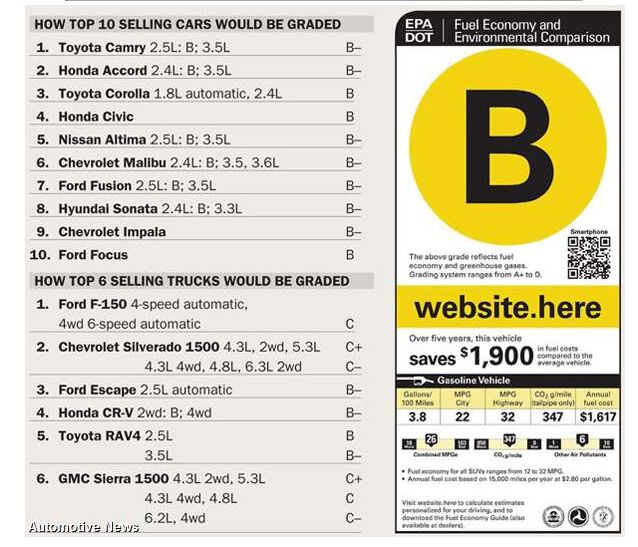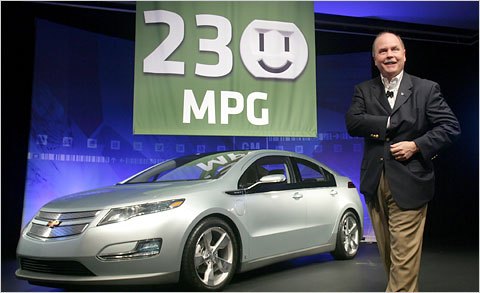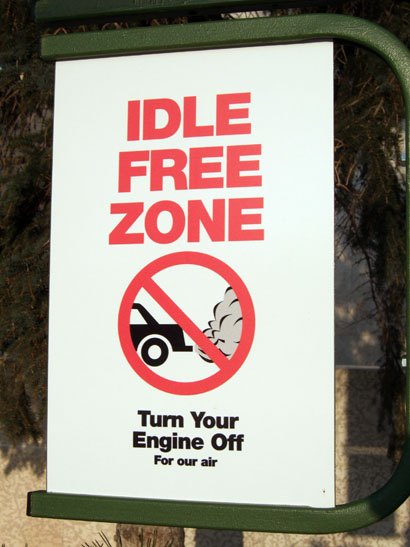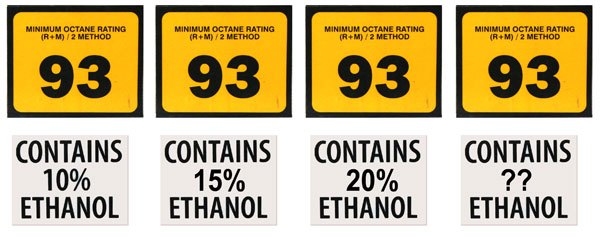#epa
Survey Says: Proposed EPA Letter Grades Suck
The recommendations are simple: Scrap the vertical label, lose the letter grade and emphasize the mpg and cost of owning the vehicle. If the EPA takes these steps, it may be successful in increasing the number of fuel-efficient vehicles on the road and communicating clearly with consumers.
Alan Siegel of brand consultants Siegel+Gale summarizes his firm’s independent research on proposed EPA fuel economy label designs in Automotive News [sub]. Siegel interviewed 456 prospective new car buyers, and found that 66 percent preferred the “horizontal” proposal, while 47 percent found the “vertical” style (which includes the letter grade) “confusing.” No word on what percentage found the letter grades to be “asinine.”
EPA Grades America's Best-Selling Cars
I See Millions Of Hybrids In Toyota's Future
Toyota launched their hybrid Prius in late 1997. 13 years later, Toyota has sold a total of about 2.6m hybrids, says The Nikkei [sub]. That mostly because it is the top selling car in Japan. And also “thanks to government subsidies that favor hybrids over other fuel-efficient cars,” as Automotive News [sub] remarks. Toyota doesn’t want to rest on its laurels.
What's Wrong With This Picture: Hungry Like A Wolf Edition
EPA Resists Cheap BP Spill Symbolism, Delays Ethanol Blend Hike
America’s ethanol producers were some of the few Americans optimistic or cynical enough to find a bright side to the BP Gulf spill. Ethanol’s lobbyists-in-chief, GrowthEnergy, decided it would be real cute to run ads highlighting all the bad things ethanol hadn’t done. One of which is not “ Ethanol has never harmed the Gulf of Mexico,” by the way. As the ad parody above points out though, even if the ethanol was creating a dead zone in the Gulf of Mexico for years before the BP spill, there are quite a few other things ethanol hasn’t done. Like this, just in from the AP [via Google]: convince the EPA to buy into its shameful, manipulative PR line and rush a decision on increasing blending limits.
The EPA's Ten Most-Efficient Vehicles Since 1984
- 2000 Honda Insight 5MT CVT (49/61/53)
- 2010 Toyota Prius (51/48/50)
- 1986 Chevrolet Sprint ER 5MT (44/53/48)
- 1990-1994 Geo Metro XFI 5MT (43/52/47)
- 1986-87 Honda Civic Coupe HF 5MT (42/51/46)
- 1994-95 Honda Civic Hatchback VX 5MT (39/50/43)
- 2006-2010 Honda Civic Hybrid CVT (40/45/42)
- 2010 Honda Insight CVT (40/43/41)
- 2001-2003 Toyota Prius CVT (42/41/40)
- 1989 Chevrolet Sprint/Suzuki Swift 5MT (38/45/41)
Keep in mind that this list [via our pals at Autosavant] is for EPA ratings, adjusted to the new post-2008 methodology (city/hwy/combined). Luckily, the EPA also accepts real-world mileage submissions from citizen-motorists to help illustrate the whole “your mileage may vary” thing. That list is after the jump.
Volt Birth Watch 185: EPA Still Not Buying 230 MPG Number
Production of Chevy Volt “integration models” began last week, as Hamtramck tools up for final production of GM’s wundercar, but GM still isn’t saying anything about the car’s two most important features: the pricetag and EPA rating. The General has hemmed and hawed on the Volt’s price over the last several years of hype, but it hasn’t ever been shy about touting an “expected” 230 MPG rating. Because apparently it’s the EPA’s job to clear up GM’s misleading marketing claims. So what is the deal with that 230 MPG number, anyway?
Damn The EPA: Mazda Makes All Cars Idle Free
By 2015, no new car made by Mazda will stand around idle. By this year, Mazda plans to install its idling stop function on all of its new automobiles, says today’s Nikkei [sub]. Some domestic and European Mazda already have this feature. In a few years, it will be universal, including North America, where current EPA regulations discourage idle stop.
NHTSA: Congressional Blocking Of EPA GH Gas Rules May Backfire
The Obama Administration warns that automakers could be hit with unintended acceleration of their costs if Congress succeeds in blocking EPA greenhouse gas emissions. The Detroit News reports:
In a letter to congressional leaders, the National Highway Traffic Safety Administration’s chief counsel, O. Kevin Vincent, said Congress would jeopardize a deal reached by automakers, California and the White House if it blocks the EPA from using its power to limit greenhouse gases.
California and a dozen states could go forward, each with its own rules, if Congress blocks EPA from setting national standards. That would have the impact of “creating confusion, encouraging renewed litigation, and driving up the cost of compliance to automobile manufacturers and consumers alike,” Vincent wrote.
Why Obama Won't Take Your Porsche Away – Takes One, Two, Three And Four
Take One: The Ruf 911 Greenster EV. From AB Green’s report:
Last fall, Porsche high performance tuning specialist Ruf announced that it had built a prototype electric sports car called the eRuf which was essentially a lithium ion battery-powered 911. That was just the beginning of the story as the company has brought the Greenster here to Geneva. The Greenster is a targa top 911 in the old style with a chopped speedster type windshield. In the back sits a 270 kW Siemens electric motor with 695 lb-ft of torque. The battery pack system has been improved and is now 30 percent smaller in volume, restoring the front trunk space that was lost on the original. The battery pack now has greater power capacity allowing it to release and absorb power faster, enabling more regenerative braking capacity. The battery can apparently be charged in only one hour from a 400V outlet. The next iteration will switch to a twin motor setup and the company is planning a small series production run in 2010.
Porsche 911 have been a favorite target for EV conversions fir decades. Ruf’s version is almost series ready. It will probably have an EPA mpge rating similar to the Tesla’s 256 mpge. How many would Porsche have to sell to increase its fleet average to the amount necessary?
Why The Chevy Equinox EPA Mileage Numbers Don't Add Up
TTAC GM Bashing Alert! The following article has been read and reviewed by the TTAC-GM Assault Protective Services Committee and has been found to contain material that may put GM in a negative light. Reader discretion is advised.
Unless the elves are asleep at Google, the odds are good that there will be an ad for the 2010 Chevrolet Equinox immediately to the right of this article. And it will proudly trumpet its 32 mpg EPA highway rating, like every other Equinox ad. From GM’s first gleeful announcement, it was hard to swallow from the that a tall, almost 4,000 lb CUV could actually get 32 mpg on the highway, or 26 mpg combined. It appears others are having the same blockage of the pharynx. Now that there’s a number of reviews out, they all show the same pattern: the Equinox EPA numbers are highly deceptive. But would the EPA ever come down on Government Motors?
Mazda: EPA Test Keeps Stop-Start Out
Idle-stop technology, which turns off a car’s engine instead of idling, is available from a number of automakers in the European and Japanese markets. Mazda claims nearly half of its Mazda3 compacts and Biante minivans sold in Japan are ordered with the $500 option, as consumers seek out fuel economy improvement without the cost of a full hybrid system. So, why doesn’t Mazda sell idle-stop equipped cars in the US? According to the company, though Japanese fuel economy tests show stop-start improving efficiency by seven to nine percent “the EPA city-mode test cycle includes only one complete vehicle stop, so stop-start technology registers only a 0.1- or 0.2-mpg improvement.” And who would pay $500 for that?
EPA Won't Rule On E15 Based On Two Cars Worth Of Data
Well, the good news is that the EPA has thus far refused to allow gasoline blends of more than ten percent ethanol. The bad news is that the Agency has yet to take a firm stand against the idea of eventually allowing E15 into the nation’s gas pumps. In fact, as the EPA’s response to the ethanol lobbying group Growth Energy’s request to allow E15 [ full document in PDF form here] opens:
It is vitally important that the country increase the use of renewable fuels. To meet that goal EPA is working to implement the long-term renewable fuels mandate of 36 billion gallons by 2022. To achieve the renewable fuel requirements in future years, it is clear that ethanol will need to be blended into gasoline at levels greater than the current limit of 10 percent.
E85 Boondoggle Of The Week: Blend Cap Decision Coming This Week
The EPA is set to rule as soon as tomorrow on the so-called “blend cap,” which forbids the sale of gasoline with more than ten percent ethanol. The petition to raise the blend cap came from a relatively new pro-ethanol lobbying group, Growth Energy, which requested the cap be moved to fifteen percent ethanol. Growth Energy’s request cites foreign oil dependence, “green-collar jobs” and the future of cellulosic ethanol as reasons to bump the blend cap, but as the New York Times reports, the real problem is that the ten percent limit is bumping up against a congressional mandate to blend 15b gallons of biofuels with gasoline by 2012. What the Times fails to mention is the financial incentive for raising the blend cap: the 51 cent-per-gallon of ethanol blended tax credit. In 2007, when gas consumption was at an all-time high and ethanol blending mandates required a mere 4.7b gallons (with 7b actually blended), that credit cost taxpayers nearly $3b. In 2012, when the mandate hits 15b gallons, the taxpayer tab will be closer to $7.65b.



























Recent Comments